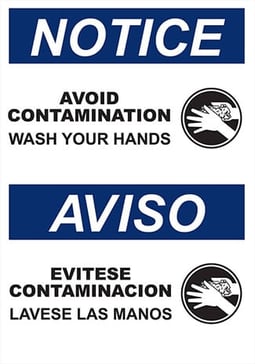5 Easy Ways to Strengthen Bloodborne and Airborne Safety Management
03
February,
2023
2 MINUTE READ

Infectious disease control has been going beyond the healthcare sectors in the past year, marked heavily by the tumultuous COVID-19 pandemic and the protocol for keeping workers and visitors safe in the workplace. How has safety management changed when it comes to airborne and bloodborne pathogens in facilities? The requirements for hazardous waste have been a foundation. It mostly boils down to having personal protective equipment and carefully instructing workers through clear and consistent messaging.
New Precautions
With new protocols for safety management, which include improved airborne safety plans, the Food and Drug Administration reminds workplaces to take precautions for bloodborne pathogen exposures. According to the National Institute for Occupational Safety and Health (NIOSH), there are about 800,000 needlestick injuries annually. Needlesticks can spread pathogens such as hepatitis and HIV.
Some of the top occupations affected by bloodborne pathogens are healthcare workers and maintenance and waste workers. Bloodborne pathogen violations are also common in food production facilities, typically as a secondary violation to other citations such as for amputations.
"Just like all industries, a number of unique hazards present themselves every day in the cleaning sector. Cleaning employees may be exposed to hazardous chemicals or work with equipment that is detrimental to their physical health over time," according to Outstanding Cleaning Inc., which specializes in commercial cleaning and sanitation in Boston, Massachusetts.
The Occupational Safety and Health Administration provides certain standards to help cut down on hazards, commercial cleaning service insurance, and injuries and illnesses to cleaning professionals. These safety standards can help companies move forward without having to risk the integrity of their employees' well-being or their daily operations and workflow. OSHA also requires workplaces to update their exposure control plans annually. Here are several ways workplaces can support those blood and airborne exposure control plans.
 PPE: Keep eyewear, gloves, coverings, and other personal protective equipment in stock as best as possible. Storage areas should be neat, organized, and easily accessible to the workers who will be using them as part of their job duties.
PPE: Keep eyewear, gloves, coverings, and other personal protective equipment in stock as best as possible. Storage areas should be neat, organized, and easily accessible to the workers who will be using them as part of their job duties. - HVAC: While air filtration should meet Minimum Efficiency Reporting Value (MERV) standards, overall HVAC conditions should be evaluated and filtration inspected. Ventilation system upgrades or improvements ensure clean air and dilute potential contaminants. Look for ways to improve the facility's ventilation.
- Wash and Sanitization Stations: When workers are exposed to potentially infectious materials, they should immediately flood the exposed area with water, cleanse wounds with soap, and seek medical attention, according to OSHA. Make sure eyewash stations are stocked, clean, and easily accessible to workers always.
- Emergency/First Aid: First-aid stations should be clean, organized, and accessible. Depending on the facility's size, make sure there are enough throughout the workplace.
- Sharps Containers: Provide the proper receptacles for sharps and dispose of them at specified disposal centers. To find one in your state or area, visit: https://safeneedledisposal.org/
Mitigation Goals
Making the necessary improvements and upgrades to support the control of airborne and bloodborne pathogens doesn't have to be all at one time. Workplaces should start with a job hazard analysis to find gaps in coverage and collaborate on ways to make the facility safer. Safety managers can then run down the list of necessary improvements and set routine maintenance as well as facility goals.
Make training of workers on the protocol for air and bloodborne pathogen hazard mitigation and safety a regular part of workplace safety plans. Reinforce that training and support air and bloodborne pathogen safety plan with strong visual communication. Highlight stations and post instructions through durable signs and labels. Mark sharps containers. Explain rules on waste management along with hazardous waste protocol. Create boundaries around workspaces where air particles can be dangerous, electrical equipment, and more with floor markings.
Many workplaces have learned the hard way from the past year's pandemic on how important it is to protect workers from new and changing environments. Workplaces that follow best practices for air and bloodborne pathogen prevention create a safer environment for workers and strengthen the company's bottom line.
RELATED RESOURCES

Avert Chemical Safety Program Failures
Facilities that handle chemicals need to be aware of the potential hazards of each chemical. Part of ...
Read
Lean and Safety Intersect at Miller Fabrication
Starting out as a small welding company 56 years ago, Miller Fabrication Solutions has successfully ...
Read
Energize Workplace Electrical Safety Plans
Each May, the Electrical Safety Foundation International highlights the importance of electrical safety by ...
Read.png)


